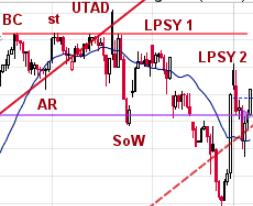Wyckoff Method Applied in the Intraday Timeframe
Market analysis and trading strategies are two essential components of successful trading. Traders utilize various methods and techniques to predict market movements and make informed decisions to maximize profits. Among the several popular methods, the Wyckoff Method stands out for its nuanced approach to reading market dynamics. In this article, we delve into how the Wyckoff Method can be effectively applied in the intraday timeframe to enhance trading outcomes.
The Wyckoff Method, developed by Richard D. Wyckoff in the early 20th century, is based on the principle of understanding the intentions of large operators in the market. By closely observing price and volume dynamics, traders following the Wyckoff Method aim to uncover the underlying forces driving market movements. This method emphasizes the importance of tracking accumulation and distribution phases to anticipate potential price trends.
In the intraday timeframe, where price movements can be swift and unpredictable, applying the Wyckoff Method can provide traders with valuable insights into short-term market actions. One key aspect of Wyckoff analysis in the intraday timeframe is identifying the regions of price support and resistance. By plotting intraday price levels and volume data, traders can pinpoint areas where buying or selling pressure is likely to emerge, enabling them to make well-informed trading decisions.
Another crucial element of the Wyckoff Method in the intraday timeframe is analyzing price and volume relationships. Monitoring the interaction between price movements and trading volumes can reveal valuable information about the strength of market trends and potential reversals. Traders can look for instances where price movements are accompanied by high trading volumes, indicating strong market participation and confirming the validity of a trend.
Moreover, traders employing the Wyckoff Method in the intraday timeframe often focus on identifying price consolidations and breakouts. Consolidation patterns, such as triangles or rectangles, can provide important clues about the market’s indecision and potential future price movements. By observing volume behavior during consolidation phases, traders can anticipate the direction of a possible breakout and position themselves accordingly to capitalize on price trends.
Additionally, the Wyckoff Method emphasizes the importance of market sentiment and the psychology of market participants. In the intraday timeframe, shifts in sentiment can occur rapidly, leading to sudden price spikes or reversals. By staying attuned to market news, economic events, and sentiment indicators, traders can gauge the prevailing mood in the market and adjust their trading strategies accordingly.
In conclusion, the Wyckoff Method offers a comprehensive framework for analyzing market dynamics and making informed trading decisions in the intraday timeframe. By applying this method effectively, traders can gain a deeper understanding of price movements, identify key support and resistance levels, and anticipate potential trend reversals. Incorporating Wyckoff analysis into intraday trading strategies can improve trading outcomes and enhance overall profitability in the fast-paced world of intraday trading.

